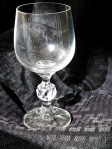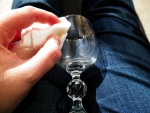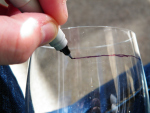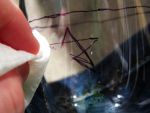Reposted with permission from https://kaloethina.wordpress.com.
Original post appeared October 19, 2014
About a week ago, I posted photos of my Rose in Any Medium goblet entry that I did with diamond point engraving. I also promised those in the Artisans of the Society for Creative Anachronism Facebook group that I would publish a tutorial on how to decorate glass with this technique.
Here’s what you will need:
 A glass object (most engraved pieces in period were either goblets or plates. I’ve had better luck with goblets, but your mileage may vary. I purchase most of my glass for these projects at thrift stores, but I’ve also had luck finding cheap Libbey-ware at the dollar store.)
A glass object (most engraved pieces in period were either goblets or plates. I’ve had better luck with goblets, but your mileage may vary. I purchase most of my glass for these projects at thrift stores, but I’ve also had luck finding cheap Libbey-ware at the dollar store.)
Permanent markers (I am fond of using multiple widths – I’ve got brush tips, fine tips, ultra-fine tips . . . they all work for this. Do not use china markers for this project. Repeat. Do not use china markers for this project. They will mess up your diamond tip. Don’t ask me how I know.)
Rubbing alcohol (you’ll see why later!)
 A diamond-point engraver (these can be purchased from Ted Pella as a “diamond scribe,” and it may be more inexpensive to go with an angled tip and with a pair of pliers, gently shape into a straight scribe. Originally made for the science industry, these are great for creating random bits of SCA pretty!)
A diamond-point engraver (these can be purchased from Ted Pella as a “diamond scribe,” and it may be more inexpensive to go with an angled tip and with a pair of pliers, gently shape into a straight scribe. Originally made for the science industry, these are great for creating random bits of SCA pretty!)
Paper or low-lint fabric towels (again, you’ll see why later)
Safety glasses (you will be making glass chips. Need I say more?)
Optional items
A plastic storage container, lined with soft material (mostly because I have found that this can be very taxing on hands, and well, glass is fragile)
A pencil grip (you are putting a lot of pressure on hands and fingers on a metal scribe, which fatigues the hands. Using a pencil grip to help cushion may help you out)
Sketched art of common motifs as found in period and tape (if you have difficulties drawing, but can trace, this can help you out a lot)
Process
Ready to get started? Excellent!
 Step one: Use the rubbing alcohol and paper towels to clean your glass of any oils, gack, or china marking pencils (like my local thrift stores are fond of using). You may also run your piece through the dishwasher, and then use the rubbing alcohol, but the key is to have a super-clean surface. The reasoning for having a super-clean surface is so the engraver can stay in contact with the glass as you sketch your drawing onto it. Also, take this time to inspect your piece. It should have no bubbles, cracks, etc. If it does, this can cause the piece to break while you’re working on it.
Step one: Use the rubbing alcohol and paper towels to clean your glass of any oils, gack, or china marking pencils (like my local thrift stores are fond of using). You may also run your piece through the dishwasher, and then use the rubbing alcohol, but the key is to have a super-clean surface. The reasoning for having a super-clean surface is so the engraver can stay in contact with the glass as you sketch your drawing onto it. Also, take this time to inspect your piece. It should have no bubbles, cracks, etc. If it does, this can cause the piece to break while you’re working on it.
Step two: Take your permanent markers, and start sketching your design on the surface. If you cannot
 draw, tape art of your motif on the inside of the glass, and trace with the marker on the outside. The downside of this method is that the design can become warped. When you do your layouts, remember that what you draw out will look frosted over, and while you can do hatching, it will look darker or different.
draw, tape art of your motif on the inside of the glass, and trace with the marker on the outside. The downside of this method is that the design can become warped. When you do your layouts, remember that what you draw out will look frosted over, and while you can do hatching, it will look darker or different.
 Do not worry if you make a mistake at this point. Use your rubbing alcohol to clean up any mistakes and keep going – at this point, you’re doing your layout, and details may change from this point forward. Also, do not worry if the ink comes off before you want – keep your permanent marker nearby and draw the detail back in.
Do not worry if you make a mistake at this point. Use your rubbing alcohol to clean up any mistakes and keep going – at this point, you’re doing your layout, and details may change from this point forward. Also, do not worry if the ink comes off before you want – keep your permanent marker nearby and draw the detail back in.
Step three: Put on your safety glasses, uncap your engraver, and start scratching away on your lines. Every engraver has a “side,” meaning that there
 is a sharper side that will be easier to scratch with. Additionally, you will need to use some pressure, and this is truly the nerve-wracking part, as calibrating the proper amount of pressure takes practice. You’ll also want to be able to wipe away glass chips as you go, as these can accumulate on the glass itself. At this point, you’ll be scratching on the lines you’ve drawn on the outside. Work until you’re happy with it.
is a sharper side that will be easier to scratch with. Additionally, you will need to use some pressure, and this is truly the nerve-wracking part, as calibrating the proper amount of pressure takes practice. You’ll also want to be able to wipe away glass chips as you go, as these can accumulate on the glass itself. At this point, you’ll be scratching on the lines you’ve drawn on the outside. Work until you’re happy with it.
Tips
For straight lines going around the glass, you can place your engraver on a pile of books or magazines, press down on the engraver, and rotate the glass. However, depending on the thickness of your glass, this may or may not remove a well-formed ring of glass (which looks cool, yes, but shortens the glass and can create further issues, as the rim is now sharp).
Have spare glasses at the ready. Breakage doesn’t happen often, but it is a risk.

You must be logged in to post a comment.